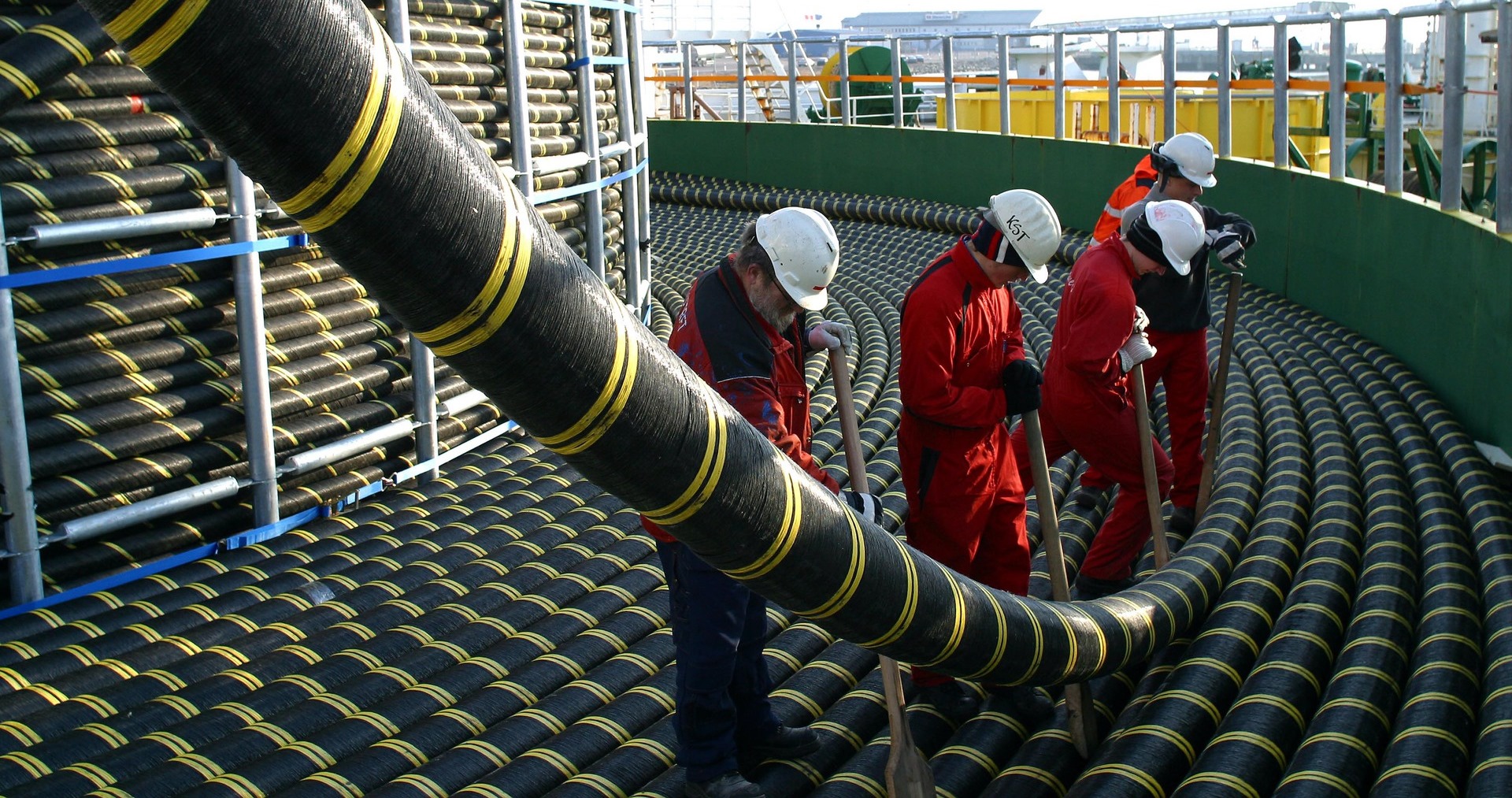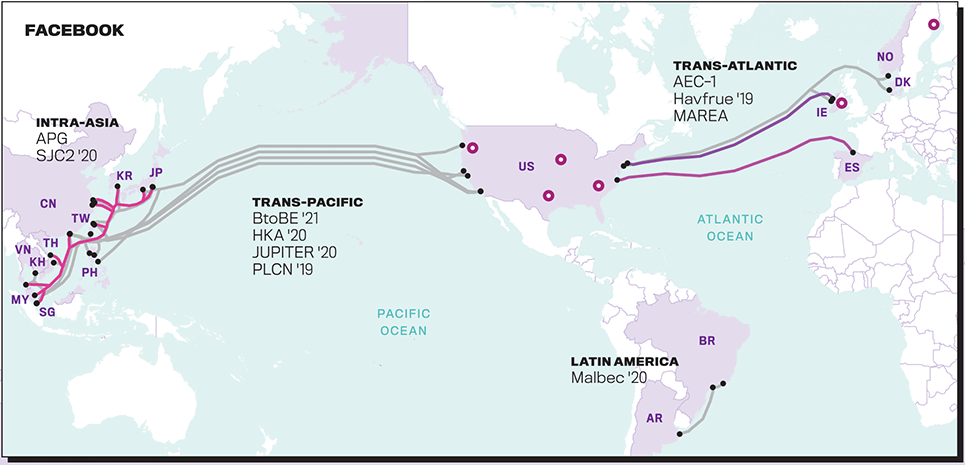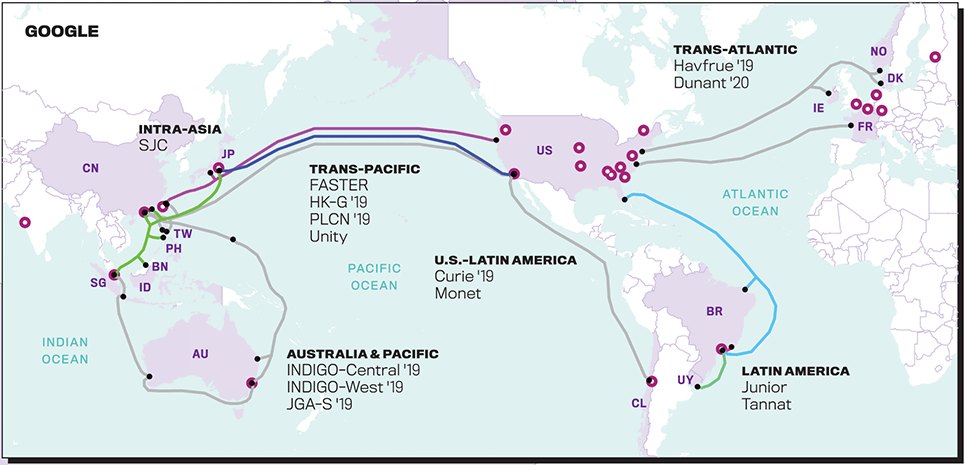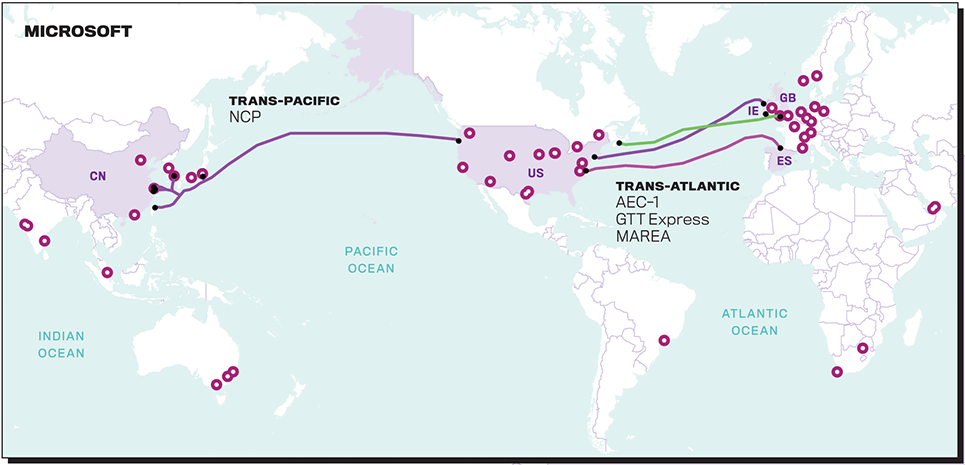Lead from the bottom: IT giants began to actively build their own underwater backbone networks
We have long been accustomed to, that large IT-companies are not only engaged in the release of products and services, but also actively participate in the development of Internet infrastructure. Google's DNS, cloud storage and hosting Amazon, Facebook data centers around the world — fifteen years ago it seemed too ambitious, and now it’s the norm everyone is used to.
And so, the four largest IT companies in the face of Amazon, Google, Microsoft and Facebook have reached the point that they started investing not only in data centers and servers directly, but also in the trunk cables themselves - that is, they entered the territory that traditionally was area of responsibility completely different structures. And, judging by the conclusions in the APNIC blog , the aforementioned quartet of technological giants struck not just on the ground networks, but on the main transcontinental communication lines, i.e. all of us are familiar submarine cables.

')
The most amazing thing is that there is no urgent need for new networks, but companies are actively increasing their throughput. Unfortunately, it’s almost impossible to find intelligible statistics about global traffic generation thanks to numerous marketers who operate with dimensions like “65 million posts on Instagram daily” or “N search queries on Google” instead of transparent and understandable petabyte technicians. It can be carefully assumed that daily traffic is ≈2.5 * 10 ^ 18 bytes, or about 2500 petabytes of data.
One of the reasons why modern backbone networks should expand is the growing popularity of the Netflix streaming service and the parallel growth of the mobile segment. With a general trend to increase the visual component of video content in terms of resolution and bit rate, as well as an increase in the consumption of mobile traffic by an individual user (against the background of a general slowdown in sales of mobile devices around the world), the backbone networks are still not overloaded.
Let's turn to Google’s underwater internet map :

It is visually difficult to determine how many new routes have been laid, and the service itself is updated almost daily, without providing a coherent history of changes or any other combined statistical data. Therefore, we turn to older sources. According to the information already on this card (50 Mb !!!) , the capacity of the existing intercontinental backbone networks in 2014 was about 58 Tbit / s, of which only 24 Tbit / s were actually used:

For those who angrily knead their fingers and prepare to write: “I do not believe! Too little! ”, We recall that we are talking about intercontinental traffic , that is, it is a priori much lower than within a specific region, since we have not yet curbed quantum teleportation and cannot hide from ping in 300-400 ms.
In 2015, a forecast was made that from 2016 to 2020, a total of 400,000 km of trunk cables would be stretched across the ocean floor, which would significantly increase the throughput capacity of the worldwide network.
However, if we look at the statistics shown on the map above, specifically about the 26 Tbit / s load with a common channel of 58 Tbit / s, then natural questions arise: why and why?
Firstly, IT giants started laying their own backbone networks for the sake of increasing the connectivity of elements of the internal infrastructure of companies on different continents. It is because of the previously mentioned ping in almost half a second between two opposite points of the globe, IT companies have to excel in matters of ensuring the stability of the work of their "economy". Most acutely, these issues are facing Google and Amazon; the first ones started laying their own networks back in 2014, when they decided to “push” the cable between the east coast of the United States and Japan to connect their data centers, which they wrote about in Habré then . Only for connecting two separate data centers, the search giant was ready to spend $ 300 million and stretch about 10 thousand kilometers of cable along the bottom of the Pacific Ocean.
If someone didn’t know or forgot, then the submarine cable installation is a quest of increased complexity, ranging from diving reinforced structures with a diameter up to half a meter in coastal zones and ending with endless landscape exploration for laying the main part of the highway at a depth of several kilometers. When it comes to the Pacific Ocean, the complexity only increases in proportion to the depth and number of mountain ranges on the ocean floor. Such events require specialized vessels, a specially trained team of specialists and, in fact, several years of hard work, considering laying from the design and exploration stage, to, in fact, the final commissioning of a network site. Plus, here you can add coordination of works and construction of relay stations on the coast with local governments, work with environmentalists who monitor the preservation of the most habitable coastal line (depth <200 m) and so on.
It is possible that in recent years new vessels were commissioned, but five years ago, the main cable spreaders of the same Huawei (yes, the Chinese company is one of the leaders of this market), there was a solid lineup for many months in advance. Against the background of all this information, the activity of technological giants in this segment looks more and more interesting.
The official position of all large IT companies: ensuring connectivity (independence from common networks) of their data centers. But what the underwater maps of different market players look like according to telegeography.com :




As seen on the maps, the most impressive appetites are not from Google or Amazon, but from Facebook, which has long ceased to be “just a social network.” There is also a clear interest of all major players in the Asia-Pacific region, and only Microsoft is still reaching for the Old World. If it is trivial to count the marked lines, then you can find out that only these four companies are co-owners or full owners of 25 already built or finally planned to lay trunk lines, most of which are drawn in the direction of Japan, China and all of Southeast Asia. At the same time, we present only statistics on the four IT giants mentioned earlier, and besides them, Alcatel, NEC, Huawei and Subcom are actively building their own networks.
In general, the number of private or privately owned transcontinental highways has increased significantly since 2014, from the time Google announced the previously mentioned connection of its data center in the United States to a data center in Japan:

Actually, the motivation “we want to link our data centers” is insufficient: companies hardly need binding for the sake of binding. Rather, they want to isolate transmitted information and secure their own internal infrastructure.
If we take a foil hat out of the table drawer, straighten it and pull it tighter, then we can formulate a very, very cautious hypothesis of the following plan: now we are watching the emergence of the Internet of a new formation, in fact, a global corporate network. If we recall that Amazon, Google, Facebook and Microsoft account for at least half of the global consumption of traffic (Amazon hosting, Google search and services, Facebook and Instagram social networks, and Microsoft Windows-based desktops), then you need to get the second cap. Because in theory, in a very vague theory, if projects like Google Fiber (this is the one in which Google tried itself as a provider for the population) will appear in the regions, now we are witnessing the emergence of the second Internet, which so far coexists with the already built . How dystopian and crazy it is - decide for yourself.
And so, the four largest IT companies in the face of Amazon, Google, Microsoft and Facebook have reached the point that they started investing not only in data centers and servers directly, but also in the trunk cables themselves - that is, they entered the territory that traditionally was area of responsibility completely different structures. And, judging by the conclusions in the APNIC blog , the aforementioned quartet of technological giants struck not just on the ground networks, but on the main transcontinental communication lines, i.e. all of us are familiar submarine cables.

')
The most amazing thing is that there is no urgent need for new networks, but companies are actively increasing their throughput. Unfortunately, it’s almost impossible to find intelligible statistics about global traffic generation thanks to numerous marketers who operate with dimensions like “65 million posts on Instagram daily” or “N search queries on Google” instead of transparent and understandable petabyte technicians. It can be carefully assumed that daily traffic is ≈2.5 * 10 ^ 18 bytes, or about 2500 petabytes of data.
One of the reasons why modern backbone networks should expand is the growing popularity of the Netflix streaming service and the parallel growth of the mobile segment. With a general trend to increase the visual component of video content in terms of resolution and bit rate, as well as an increase in the consumption of mobile traffic by an individual user (against the background of a general slowdown in sales of mobile devices around the world), the backbone networks are still not overloaded.
Let's turn to Google’s underwater internet map :

It is visually difficult to determine how many new routes have been laid, and the service itself is updated almost daily, without providing a coherent history of changes or any other combined statistical data. Therefore, we turn to older sources. According to the information already on this card (50 Mb !!!) , the capacity of the existing intercontinental backbone networks in 2014 was about 58 Tbit / s, of which only 24 Tbit / s were actually used:

For those who angrily knead their fingers and prepare to write: “I do not believe! Too little! ”, We recall that we are talking about intercontinental traffic , that is, it is a priori much lower than within a specific region, since we have not yet curbed quantum teleportation and cannot hide from ping in 300-400 ms.
In 2015, a forecast was made that from 2016 to 2020, a total of 400,000 km of trunk cables would be stretched across the ocean floor, which would significantly increase the throughput capacity of the worldwide network.
However, if we look at the statistics shown on the map above, specifically about the 26 Tbit / s load with a common channel of 58 Tbit / s, then natural questions arise: why and why?
Firstly, IT giants started laying their own backbone networks for the sake of increasing the connectivity of elements of the internal infrastructure of companies on different continents. It is because of the previously mentioned ping in almost half a second between two opposite points of the globe, IT companies have to excel in matters of ensuring the stability of the work of their "economy". Most acutely, these issues are facing Google and Amazon; the first ones started laying their own networks back in 2014, when they decided to “push” the cable between the east coast of the United States and Japan to connect their data centers, which they wrote about in Habré then . Only for connecting two separate data centers, the search giant was ready to spend $ 300 million and stretch about 10 thousand kilometers of cable along the bottom of the Pacific Ocean.
If someone didn’t know or forgot, then the submarine cable installation is a quest of increased complexity, ranging from diving reinforced structures with a diameter up to half a meter in coastal zones and ending with endless landscape exploration for laying the main part of the highway at a depth of several kilometers. When it comes to the Pacific Ocean, the complexity only increases in proportion to the depth and number of mountain ranges on the ocean floor. Such events require specialized vessels, a specially trained team of specialists and, in fact, several years of hard work, considering laying from the design and exploration stage, to, in fact, the final commissioning of a network site. Plus, here you can add coordination of works and construction of relay stations on the coast with local governments, work with environmentalists who monitor the preservation of the most habitable coastal line (depth <200 m) and so on.
It is possible that in recent years new vessels were commissioned, but five years ago, the main cable spreaders of the same Huawei (yes, the Chinese company is one of the leaders of this market), there was a solid lineup for many months in advance. Against the background of all this information, the activity of technological giants in this segment looks more and more interesting.
The official position of all large IT companies: ensuring connectivity (independence from common networks) of their data centers. But what the underwater maps of different market players look like according to telegeography.com :




As seen on the maps, the most impressive appetites are not from Google or Amazon, but from Facebook, which has long ceased to be “just a social network.” There is also a clear interest of all major players in the Asia-Pacific region, and only Microsoft is still reaching for the Old World. If it is trivial to count the marked lines, then you can find out that only these four companies are co-owners or full owners of 25 already built or finally planned to lay trunk lines, most of which are drawn in the direction of Japan, China and all of Southeast Asia. At the same time, we present only statistics on the four IT giants mentioned earlier, and besides them, Alcatel, NEC, Huawei and Subcom are actively building their own networks.
In general, the number of private or privately owned transcontinental highways has increased significantly since 2014, from the time Google announced the previously mentioned connection of its data center in the United States to a data center in Japan:

Actually, the motivation “we want to link our data centers” is insufficient: companies hardly need binding for the sake of binding. Rather, they want to isolate transmitted information and secure their own internal infrastructure.
If we take a foil hat out of the table drawer, straighten it and pull it tighter, then we can formulate a very, very cautious hypothesis of the following plan: now we are watching the emergence of the Internet of a new formation, in fact, a global corporate network. If we recall that Amazon, Google, Facebook and Microsoft account for at least half of the global consumption of traffic (Amazon hosting, Google search and services, Facebook and Instagram social networks, and Microsoft Windows-based desktops), then you need to get the second cap. Because in theory, in a very vague theory, if projects like Google Fiber (this is the one in which Google tried itself as a provider for the population) will appear in the regions, now we are witnessing the emergence of the second Internet, which so far coexists with the already built . How dystopian and crazy it is - decide for yourself.
Source: https://habr.com/ru/post/446750/
All Articles